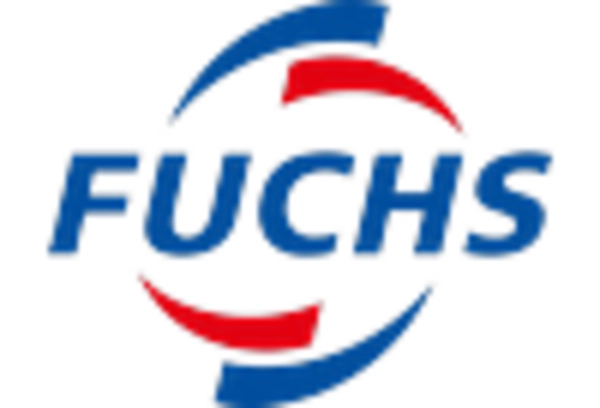Rising Automotive Production
The automotive sector plays a pivotal role in the lubricants market in North America. With the production of vehicles projected to reach approximately 12 million units in 2025, the demand for high-performance lubricants is expected to surge. This increase is driven by the need for enhanced engine efficiency and longevity, which synthetic and semi-synthetic lubricants can provide. As automotive manufacturers focus on meeting stringent emission regulations, the lubricants market in North America is likely to experience growth, as these products contribute to improved fuel economy and reduced environmental impact. Furthermore, the trend towards electric vehicles may also influence lubricant formulations, as new technologies require specialized lubricants to ensure optimal performance. Thus, the rising automotive production is a significant driver for the lubricants market in North America.
Increased Focus on Equipment Maintenance
The heightened emphasis on equipment maintenance across various sectors is a notable driver for the lubricants market in North America. As businesses recognize the importance of maintaining machinery to prevent downtime and costly repairs, the demand for lubricants is likely to increase. In 2025, it is estimated that maintenance expenditures in the manufacturing sector alone will exceed $200 billion. This trend is particularly relevant in industries such as aerospace, automotive, and manufacturing, where the reliability of equipment is paramount. The use of advanced lubricants can enhance the performance and lifespan of machinery, thereby reducing operational costs. As a result, the increased focus on equipment maintenance is expected to significantly impact the lubricants market in North America.
Industrial Growth and Infrastructure Development
The ongoing industrial growth and infrastructure development in North America are crucial drivers for the lubricants market. As industries such as manufacturing, construction, and energy continue to expand, the demand for lubricants is anticipated to rise. In 2025, the industrial sector is expected to contribute approximately $3 trillion to the North American economy, leading to increased machinery usage and maintenance requirements. This growth necessitates the use of high-quality lubricants to ensure operational efficiency and equipment longevity. Additionally, the construction of new facilities and infrastructure projects will further bolster the demand for lubricants, as heavy machinery and equipment require reliable lubrication solutions. Consequently, the industrial growth and infrastructure development present a substantial opportunity for the lubricants market in North America.
Regulatory Compliance and Environmental Standards
The stringent regulatory compliance and environmental standards in North America are driving changes in the lubricants market. As governments implement more rigorous regulations regarding emissions and environmental impact, manufacturers are compelled to develop lubricants that meet these standards. This shift is evident in the growing demand for eco-friendly and biodegradable lubricants, which are projected to capture a larger market share by 2025. Companies that adapt to these regulations not only enhance their market competitiveness but also contribute to sustainability efforts. The lubricants market in North America is likely to see an increase in the adoption of innovative formulations that align with environmental standards, thereby driving growth in this sector.
Technological Advancements in Lubricant Formulations
Technological advancements in lubricant formulations are significantly influencing the lubricants market in North America. Innovations in chemistry and materials science are leading to the development of high-performance lubricants that offer superior protection and efficiency. For instance, the introduction of nanotechnology in lubricant formulations is enhancing their performance characteristics, such as thermal stability and wear resistance. By 2025, it is anticipated that the market for advanced lubricants will grow by approximately 15%, driven by these technological innovations. As industries seek to optimize their operations and reduce costs, the demand for cutting-edge lubricants is expected to rise. Thus, technological advancements in lubricant formulations represent a key driver for the lubricants market in North America.


















Leave a Comment